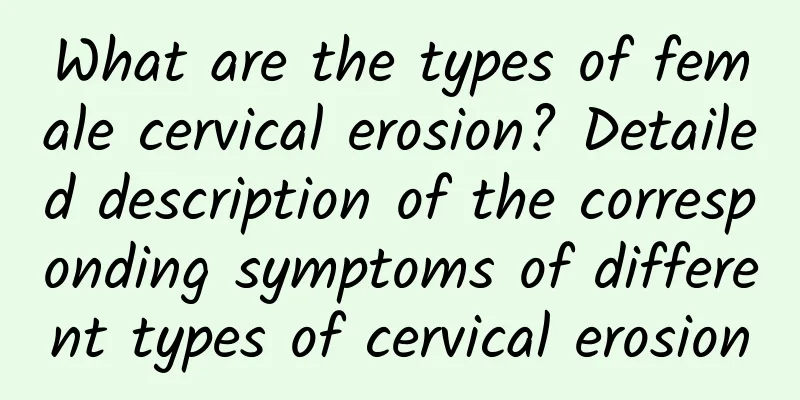What are the types of female cervical erosion? Detailed description of the corresponding symptoms of different types of cervical erosion

|
In life, cervical erosion is a complex disease that is common among women. Pathologically, there are two types of cervical erosion: true erosion and false erosion. In clinical work, many patients' symptoms are mostly false erosion. But in fact, according to the severity, symptoms and causes of the disease, the types of cervical erosion are more diverse. So, how many types of cervical erosion can be divided into? 1. Fungal cervical erosion This type of cervical erosion is also called Candida cervical erosion. It is a type with a relatively high incidence rate. The main symptoms are increased leucorrhea, which is often curd-like or lumpy. The vagina and vaginal vestibule mucosa are highly edematous and covered with a white curd-like film, which is distributed in dots or sheets and is easy to peel off. Underneath is a damaged flushing base, or ulcers are formed, and ecchymosis may also be left. In severe cases, the labia minora may swell and adhere. In addition, there are symptoms such as burning and itching of the vulva and vagina. If the urethra is affected, there will be symptoms of frequent urination, urgency, and pain when urinating. 2. Trichomonas cervical erosion What are the types of cervical erosion? The main symptom of trichomoniasis cervical erosion is also an increase in leucorrhea, and the leucorrhea is thin and serous, and can also be grayish yellow or yellow-green, sometimes mixed with blood. About 20% of women have foam in their leucorrhea. Vulvar itching, burning, and sexual intercourse pain are also common. If the infection involves the urethra, there will be symptoms of urinary pain, urgency, and even hematuria. 3. Bacterial cervical erosion Clinical studies have found that about 10% to 50% of bacterial cervical erosion has no symptoms. Even if there are symptoms, there is an increase in abnormal vaginal secretions, which are thin, homogeneous or thin, pasty, grayish white, grayish yellow or milky yellow, with a fishy odor, and there may also be a burning sensation in the vagina. 4. Nonspecific cervical erosion The main symptom of nonspecific cervical erosion is usually an increase in vaginal discharge, which may be purulent or serous, and in severe cases, may have a foul odor. The discharge irritates the urethra, causing urinary urgency, pain, a sense of falling in the vagina, burning sensation, pelvic dysfunction, and general fatigue. |
Recommend
What are the symptoms of cervical cyst in early pregnancy
What are the symptoms of cervical cyst in early p...
Several methods of treating cervical hypertrophy
Cervical hypertrophy is a common disease in women...
Burning fat requires high CP value to increase the effect of exercise
I have been running on the treadmill for 30 minut...
Early detection of vaginitis symptoms is important
The anatomical characteristics of the female vagi...
What are the precautions for pelvic inflammatory disease
Pelvic inflammatory disease is a common gynecolog...
What are the symptoms of acute adnexitis?
Acute adnexitis is a common disease. Do you know ...
Is immunotherapy necessary for abortion?
When visiting the clinic, you can see that many d...
Three methods: easy and effective prevention of dysmenorrhea
What are the ways to prevent dysmenorrhea? Dysmen...
How much does a missed abortion cost?
Pregnancy is a happy thing, but some friends'...
How many days of pregnancy is better for abortion
There is no best time to have an abortion. Unders...
Winter melon is a treasure from head to toe. It helps you lose weight and beautify your skin.
Winter melon has been a good weight loss product ...
Not all menstrual cramps can be cured by just enduring them!
As for dysmenorrhea, only women can understand th...
Misconceptions about weight loss (Part 3) Is chili cream a magic tool for weight loss?
[Key Points]: Why do some people fail to lose wei...
What medicine is used to treat pelvic inflammatory disease? Through infusion and oral medication
Pelvic inflammatory disease is mainly caused by b...
Regulating the daily diet of patients with vulvar leukoplakia
Vulvar leukoplakia is generally caused by vulvar ...









